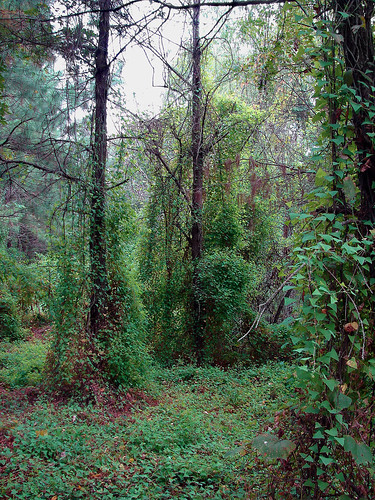A minute of natural history
 |
| Mile-a-minute overtaking trees. by Furryscaly via Flickr CC |
Mile-a-minute (Persicaria
perfoliata) is one of the most pervasive
and damaging nonnative invasive plant species in the United States. Mile-a-minute, a member of the Buckwheat
family (Polyganaceae), was first introduced to the U.S. in 1890 from its indigenous
range of Asian and Southeast Asia. The
plant did not successfully establish a permanent population in the U.S. until a
reintroduction in the late 1930s when a Pennsylvanian nursery germinated Holly
seeds from Japan and in doing so, the stowaway mile-a-minute seeds.
 |
| Approximate U.S. distribution as of July 2013. Source: Eddmaps.
www.eddmaps.org#sthash.Oa4NZqHa.dpuf
www.eddmaps.org#sthash.Oa4NZqHa.dpuf
|
Mile-a-minute earned its name
Mile-a-minute is an annual trailing vine with distinctive
alternate triangular leaves. Another identifying
trait is the round saucer-shaped structures, or ocreae, which occur at nodes
and branching points along the stem. Self-pollinating
flowers and subsequent fruit arise from the ocreae. Recurved barbs along the
stem and leaf petioles make this plant particularly unpalatable to most potential
herbivores. Low predation rates in the
U.S. coupled with the species’ prolific seed production and readily available dispersal
mechanisms (water and birds) are traits characteristic of an exceptionally weedy
plant.
Most impressing, and most ecologically damaging, is mile-a-minute’s
growth rate of up to six inches a day,
or 77’ (33.8 m) in a single growing season.
For perspective, mile-a-minute could cover the Statue of Liberty from
heal to torch in two growing seasons.
Methods to control this invasive plant include traditional methods of manual
removal and chemical pesticide applications.
However, given the rate at which mile-a-minute spreads, traditional
methods are not practical of well-established or remote populations. In 1996, the U.S. Forest Service began
researching possible biological control agents.
 |
| Following annual die-back mile-a-minute leaves and stems continue to weigh down the plants they have climbed and shade groundcover. by Leslie J. Mehrhoff, University of Connecticut via Invasives.org |
 |
| Mile-a-minute leaves and ocreae. by Leslie J. Mehrhoff |
Fighting nonnative with nonnative: biological control
Biological control is a way of using an invasive species
natural predator or disease, most often from the species’ indigenous region, to
reduce the invasives’ proliferation and dominance. Finding a biological control agent that is truly
host-specific to your target species takes a lot of research. Inadequate research into a control agent’s
life history and ecology prior to release may have dire consequences, which are
worse than the original cause for their introduction. A classic example of biological control gone awry
is that of Cane
Toads introduced to Australia in 1937.
Thankfully, the science of introducing biological control agents has
come a long way!
 |
| Adult R. latipes are approx. 2mm long. by Amy Diercks, via Invasives.org |
Colpetzer et al. published a study in Biological Control (2004) examining potential biological control agents for use on mile-a-minute. Results from their study supported the introduction of a small host-specific weevil from Asia, Rhinoncomimus latipes, which feeds on mile-a-minute roots as a
larvae and foliage as an adult. In 2004, the U.S. Department of Agriculture approved the use of the weevil as a biological control agent. After
several regional releases, the introduced weevils have successfully established
populations throughout the Mid-Atlantic region.
Ongoing weevil
releases, such as one recently conducted in Union County, New Jersey, help
sustain and expand the current weevil populations.
Led by state and county agriculture officials, the recent release of 2,000
weevils in Watchung Reservation, Union County’s largest park, is sure to reduce
local mile-a-minute growth in the coming years.
The below video is from a recent weevil release in New York City
Amy Diercks, Bugwood.org





